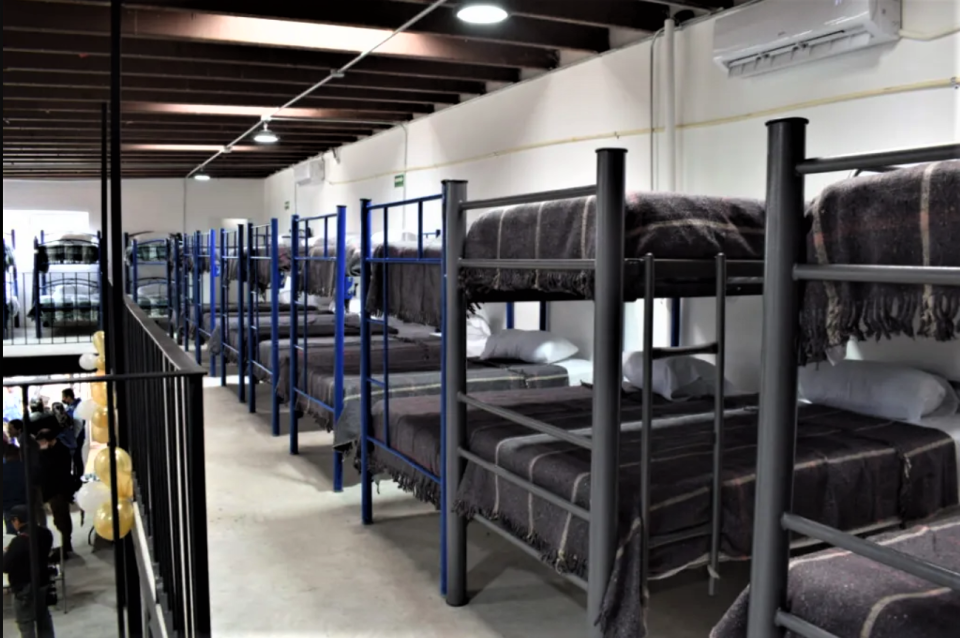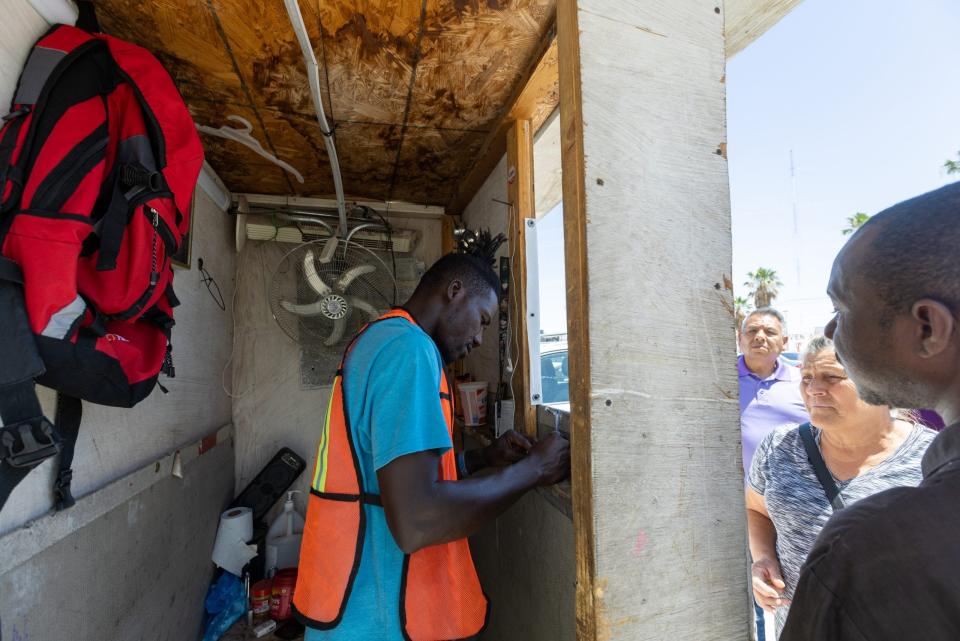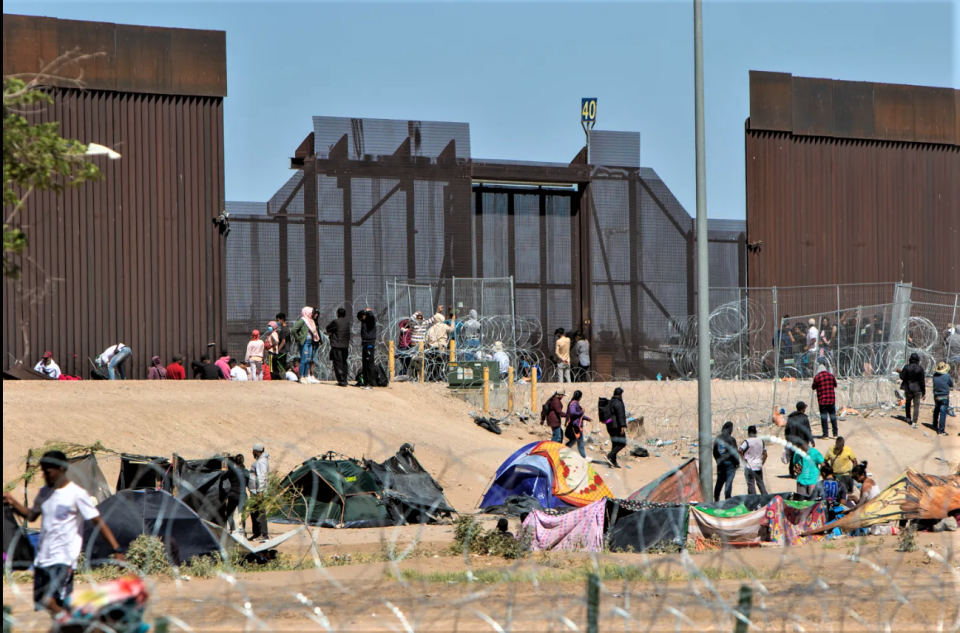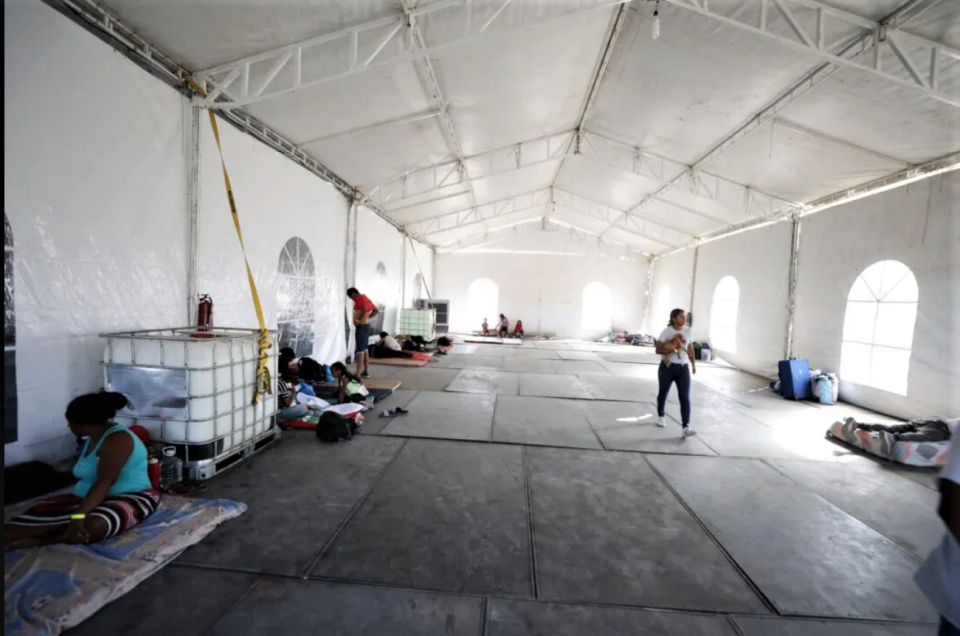Juárez has an abundance of jobs, but few migrants are seeking them; here’s why
JUÁREZ – As he walked along a trail parallel to the Rio Grande on the U.S.-Mexico border, Raul Torres pointed to the elevated Mexican levee a short distance away.
“Before, I’d see migrants walking along there, but I don’t see them much anymore. I see them now more inside the city,” he said.
It’s a routine for the 53-year-old to walk a few miles along the Rio Bravo, as the Rio Grande is called in Mexico, and Torres, a lifelong resident of Juárez, has seen the ebbs and flows of migrant populations and their impact on the city.
“Some of them work and some do not. Juárez is a noble town. Yes, it is a violent place, but it is a town with a good heart, and we respect the migrants who come to work. Anyone who comes to work, no matter where they are from, they are welcomed as Juárenses,” he said.
The Juárez region “has no unemployment” and an abundance of jobs ‒ about 30,000 ‒ that need to be filled, said Arturo Urquidi Astorga, the director of commercial compliance and regulations for businesses in Juárez. And over the past few months, an estimated 35,000 migrants have gathered in Juárez, some passing through to the U.S. and others stuck waiting to enter.
A migrant labor force of 35,000 would be beneficial, Astorga said, if all the migrants had matching skills and were available for work. But that’s not the case.
“Many are awaiting calls from immigration officials, so they do not take jobs that might require them to turn off their cellphones as is required in many maquiladoras,” he said, referring to the factories on the border.
The wide range of available jobs means “fundamentally, anyone who is not working in Juárez is not working because they do not want to work,” he said.
Tension in Juárez
While many in Juárez sympathize with the plight of newly arrived migrants, the tension is evident regarding the economic impact of their presence.
“Here in the border cities, many migrants are not working. They are not even looking for work; they are looking to other people to help them,” said Jose Silva, a 50-year-old Mexican from Reynosa who was walking along a Juárez sidewalk near the Paso Del Norte international bridge. “They are causing disturbances because … they do not have money to pay for a hotel. Yet they do not want to be in shelters. They would rather complain.”
Astorga compared the situation in Juárez to Fidel Castro’s 1980 Mariel boatlift ‒ a mass emigration of about 125,000 Cubans, including about 20% with criminal records or mental conditions, into the United States
“It’s like when Cuba sent all those people flooding to Miami in Florida,” he said. “It was not the best people that were sent, not the best people to fill good jobs.”
The hesitance for a migrant to find employment in Mexico while awaiting their chance at entering the U.S. is understandable, said Dany Bahar, a professor at Brown University who studies the economics of immigration.
“It’s not usually their intention to stay there. They want to cross into the U.S., so they’re not willing to invest in something long-term,” he said. “If you don’t want to stay somewhere, you’re not going to settle roots there. You’re not going to be willing to contribute.”
Tony Payan, director of the Center for the United States and Mexico at Rice University’s Baker Institute for Public Policy, agreed.
“They don’t see themselves as people who will settle there and engage in some kind of economic activity,” Payan said.
Some of the migrants, he pointed out, are from countries with educational systems that warn against capitalist societies.
“It’s a Marxist tradition, and they tend to associate work, especially paid work, with capitalism that is exploitative,” Payan said. “So, ideologically they’re predisposed against that.”

An additional reason that some migrants have not entered the formal workforce is the false belief that they will lose their standing in U.S. immigration proceedings if they start working.
“They have incorrect information that they would no longer be given asylum in the United States of America because they would no longer be considered refugees, “ said Isaac Leobardo Sanchez Juárez, a professor of economics at the Universidad Autónoma de Ciudad Juárez. “So, because of this, some do not want to work, and they are just waiting in Juárez, and living off of money transfers they receive or from relatives, or living off of the money they brought with them.”
The economic impact
Tracking the movement and economic impact of migrants like those in Juárez is difficult, and reliable statistics “are generally not available,” according to the Global Migration Data Analysis Centre. The biggest complication is that illegal immigration ‒ called “irregular” immigration by data gatherers ‒ is complex, mired in a swath of varying laws from overlapping countries of origin, and the data is pieced together from many different sources.
Traditionally, the flow of money is measured by remittances ‒ money sent to and from migrants and their families in their countries of origin ‒ and monitored by the World Bank. Mexico received a record $58.4 billion in remittances in 2022, which is nearly 14% more than it received in 2021 and double what it received six years ago, the World Bank data shows.
The World Bank attributed the record growth in part to “strong flows in Mexico” sent to traveling migrants from family members in their countries of origin.
Last year, the Mexican state of Chihuahua received $1.6 billion in remittances ‒ the seventh highest in Mexico ‒ with Juárez receiving $505 million, the most in the state and tenth highest in the nation.
Experts, however, caution that using remittances to determine the specific economic impact of migrants on the Mexican economy is problematic.
“The Bank of Mexico has no way to distinguish the nationality of the recipient. The bank can only determine that a remittance has entered Mexico,” said Sanchez Juárez, the economics professor.
Most of these remittances, 95%, came from people in the U.S., but they also include “funds received by transit migrants from Honduras, El Salvador, Guatemala, Haiti, Venezuela, Cuba, and others,” according to the World Bank.
Official data, however, shows only a portion of the economic impact of migrants and remittances.
According to the International Monetary Fund, “unrecorded flows through informal channels are believed to be at least 50% larger than recorded flows.” But every dollar spent by a migrant has an impact on the local community. Even the small day-to-day purchases add up.
“There is a multiplying factor when you introduce money into a community,” Payan said. “That person who receives the money is going to buy a service or a good, and that in turn feeds other supply chains down the line.”

Juárez migrants defend presence
Some of the migrants interviewed by El Paso Inc. said they promptly looked for work when they arrived in Juárez, expecting handouts only if they were without any other option. Franyer Castillo, 25, and his 20-year-old brother, Frank Castillo, left Venezuela three months ago, traveling through Colombia, Panama, Costa Rica, Nicaragua, Honduras, Guatemala and Mexico to arrive in Juárez on May 31.
After completing a shift at a nearby construction site, they sat smoking cigarettes on a bench near the Juárez mercado ‒ a bustling array of shops and canopied stands that engulf several blocks around the Misión de Nuestra Señora de Guadalupe.
“The idea is to work and get ahead,” Franyer Castillo said. “Right now, we are here willing to work in construction and painting houses so that we can survive ‒ so we can be able to eat and to pay for rent.”
The brothers estimate they each spent $2,500 to get to Juárez.
Now their time is spent looking for work to sustain them while they make regular attempts to register for a U.S. asylum meeting through the CBP One application, a notoriously glitchy portal that the U.S. government has launched as the preferred way for migrants to legally enter the country.
“We have not been able to make an appointment. But we want to do things right, to follow the process,” Frank Castillo said. “I am looking for a better future and to unite again with my family, of course.”
Aside from the sporadic income they have been able to generate through random jobs, they said family members also sent them money through Zelle and Western Union.
“But a lot of our money was stolen in Monterrey by police, about $4,000,” Franyer Castillo said. “Police have a heavy hand on migrants, stealing from them what little money they have.”

Jose Manuel Morgade, 37, was hanging merchandise ‒ baseball hats and shirts ‒ on a rack alongside a narrow walkway.
“I’m a migrant. For people to generalize that we are not contributing and that we are somehow all the same is incorrect,” said Morgade, who came to Mexico from Spain five years ago.
Negative stereotypes about migrants “generate hatred and anger against people who come from outside who are in a very bad situation and come looking for a better situation,” he said. “You cannot generalize about who comes with bad intentions. Most come escaping a horrible situation, and they want to improve and protect their human rights.”
In another section of the mercado, Jonathan Diaz Hernandez was selling electrical cords and light bulbs from a few folding tables. His challenge each day, he said, is to generate 650 pesos – $37 – to rent the space for his business and pay for food for the day, while he uses the CBP One application to secure an immigration appointment.
“I arrived in Juárez eight days ago and started looking for work to be able to sustain myself and be able to stay here,” said the Venezuelan. “Thank God I have work so I can pay for things while I wait for my appointment. I want to do everything legal. That’s why I got this job.”
His family is too poor to send him money, he said, so he’ll keep selling wares in the mercado until he can secure an immigration hearing that may pave the way for his entry into the U.S.
“The Venezuelan is always a believer and always has faith,” he said. “So, I will stay working, and I fully believe that I will get the appointment if I continue to be dedicated.”
The recent migrant surge on the southern border has slowed since Title 42 ended May 11, with arrests at the southern border dropping by 70%. CNN reported recently that the average daily encounters reported by the U.S. Border Patrol along the U.S.-Mexico border is down to 3,400 – a significant shift from the 10,000 daily encounters days before Title 42 was lifted.
“It seems to me that, in the end, the final analysis is that there may be more benefits than costs with having migrants in the community,” said Sanchez Juárez. “Their presence will translate into more consumption and, consequently, into more economic development for the place where they are living.”
Slowly, a more permanent life may emerge for many of the people stranded in Mexico as they await entry into the United States, said Payan at Rice University.
“They’re not going to be in a shelter or in a tent forever. They’re eventually going to have to find a living,” he said. “As workers, or as entrepreneurs, they will have to find a normal life again.”
This story, which originally was published on elpasomatters.org, was produced as part of the Puente News Collaborative, a binational partnership of news organizations in Juárez and El Paso.

This article originally appeared on El Paso Times: Juárez has an abundance of jobs, but few migrants are seeking them

